Whether you are looking to downsize or want to adopt a simpler lifestyle, there are plenty of low-cost small house designs you can choose from. Requiring significantly less material and a much lower budget, these designs are simply great for both your wallet and the environment. As a bonus, small houses are adorable. Low-cost, compact house designs focus on effective space optimisation, making the home appear larger than it is. Read on to learn more about how you can use even the smallest space to your advantage when designing a beautiful small home.
See also: 10 tiny home decorating designs for small houses
Low-budget house designs: Key features to look for
Designing a budget-friendly small house requires smart planning to maximize space, efficiency, and comfort while keeping costs low. Here are some key features to consider:
- Compact and Functional Layout: A well-thought-out floor plan with an open-concept design helps utilize space efficiently, reducing the need for unnecessary walls and corridors.
- Multi-Purpose Spaces: Incorporating furniture and areas that serve multiple purposes, such as foldable tables, sofa beds, and storage-integrated stairs, optimizes limited square footage.
- Affordable and Durable Materials: Using cost-effective yet durable materials like concrete blocks, locally sourced wood, and recycled materials helps reduce construction expenses while maintaining longevity.
- Energy Efficiency: Incorporating natural lighting, proper ventilation, and energy-efficient appliances minimizes long-term utility costs. Solar panels and rainwater harvesting systems can also help reduce expenses.
- Minimalist Aesthetic: Simple designs with clean lines and minimal ornamentation not only reduce construction costs but also make the space feel more open and modern.
- Prefabricated or Modular Construction: Opting for prefabricated or modular home designs can lower labor costs and speed up the construction process without compromising quality.
- Smart Storage Solutions: Built-in shelves, wall-mounted storage, and hidden compartments help maximize space without cluttering the interior.
- Low-Maintenance Design: Choosing low-maintenance flooring, weather-resistant roofing, and easy-to-clean surfaces reduces long-term upkeep costs.
- Outdoor Integration: Utilizing small gardens, patios, or rooftop terraces expands usable space and enhances the living experience without significantly increasing costs.
Top low-cost small house design ideas for you
Check out these lovely small house design ideas you can adopt.
1. Open single floor low-budget house design
One of the best single-floor home designs ever constructed at a reasonable price is the one with an open structure. An open floor plan refers to combining two or more spaces into one bigger space. The primary benefit of this design is that the house will receive a lot of sunlight and fresh air. Furthermore, everything may be visible from a single point.
See also: Ramp design ideas for you to consider
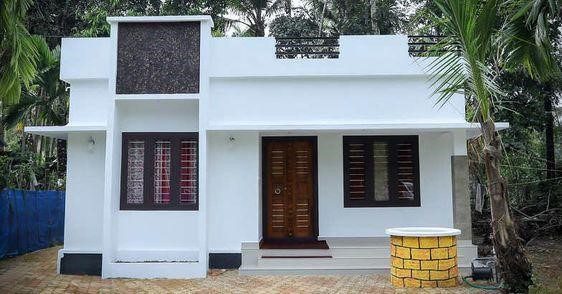
Source: Pinterest
2. Low-cost small house design with multiple sections
If you have the luxury of a large plot, erecting the house in pieces across the plot makes sense instead of creating multiple stories. For instance, take a look at this affordable one-storey home. The owner built a garage/storage area close to the main house, which is single-story, and connected the two with a covered passageway. By doing this, you can save money by getting additional carpets without creating a new floor.
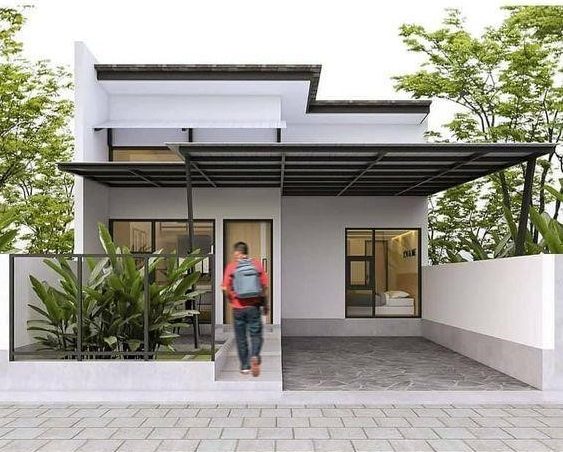
Source: Pinterest
3. Low-budget house design with an open deck
Most people don’t have enough room for a complete outside garden. In these circumstances, you can create a floor plan with an open deck that serves as a small garden space. Take this floor plan as an example. The house features an open and spacious patio in the backyard that offers more privacy. The open layout allows for natural light and fresh air throughout the year. In your low-cost home with an open deck, you can arrange for informal gatherings and parties.
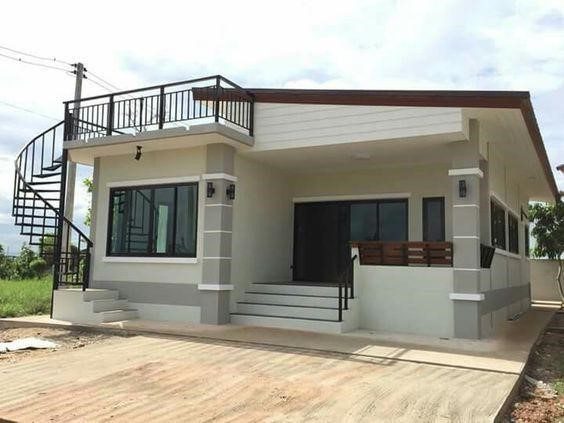
Source: Pinterest
4. L-shaped low-budget simple house design
The most popular option on the list of affordable house designs is the L-shaped one. A small, simple L-shaped dwelling maximises the use of a rectangular site by creating an L-shaped, one-story house at one end and a garden area in the front. If you desire an open garden in a limited space, you can consider this design.
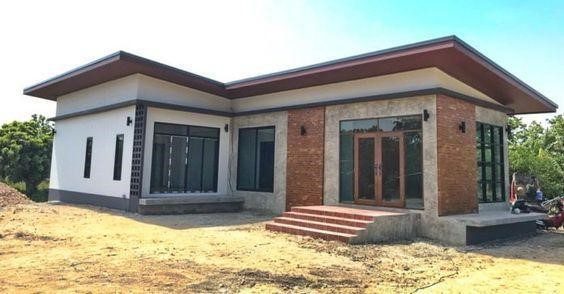
Source: Pinterest
5. Elevated low-budget house designs
Consider the scenario where your plot is situated in an area that experiences flooding during the rainy season. In that circumstance, elevating your residence is essential. Instead of the other way around, the water will flow in the direction of the road from the home. Another advantage of the height is having a great view of the surroundings. Look at this charming, modestly-priced house plan.
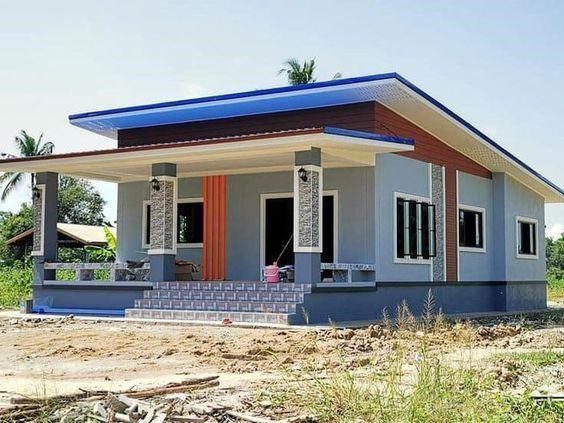
Source: Pinterest
6. Simple house design with open patios
There may not be enough space for open gardening. But don’t forget to incorporate open patios into your low-cost house plan. An open patio can be utilised in several ways. Set up some furniture so you can take advantage of the evenings outside. Additionally, the space can store bicycles, vertical shoe racks, and dry objects during inclement weather.
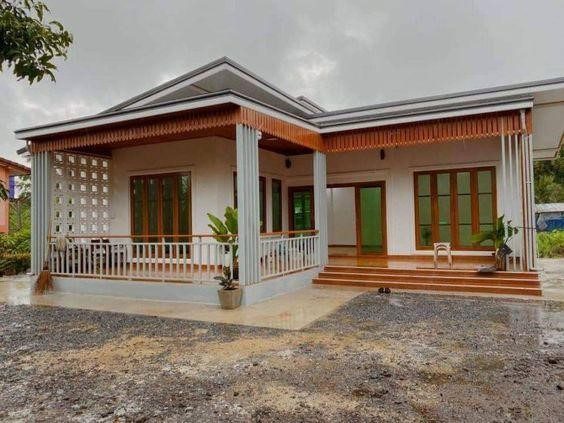
Source: Pinterest
7. Low-budget house design with exposed bricks
Exposed bricks are often used while building homes. In an exposed brick design, the bricks are left unpainted or unplastered and visible. Look at the modest, quaint house below, which has an exterior composed of exposed bricks. The benefit is that you may save money on materials and labour costs by using these bricks because they never go out of fashion. A single-level home with such a low cost can be built quickly, allowing you to move in sooner.
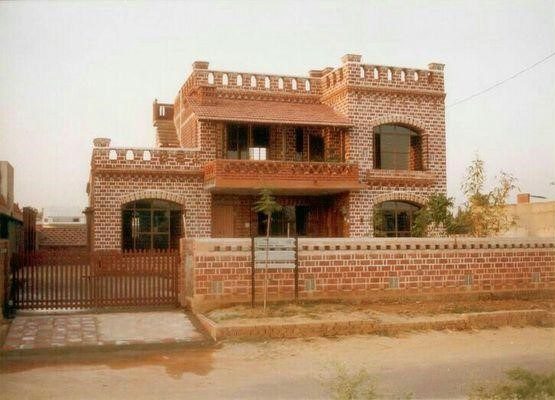
Source: Pinterest
8. Low-budget house design with a lawn
Wouldn’t it be lovely to have a garden at home that blends beauty with greenery? Mainly to save money and have a large outdoor garden area, many people choose a single-floor house design. You may gasp in awe at the stunning landscaping. The single-floor house design feels more expansive because of the use of trees and tiny plants in the garden.
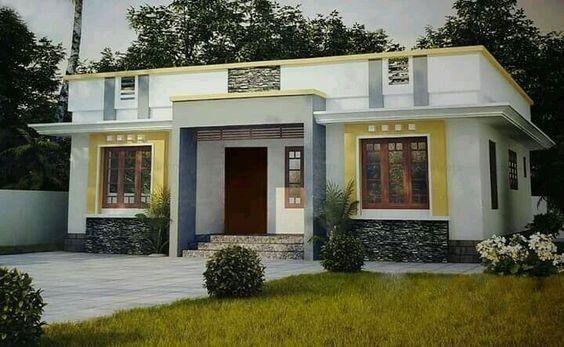
Source: Pinterest
9. Wooden and concrete simple house design
A low-cost house design of wood and concrete exudes elegance like none other. It has a straightforward design and a connected garage. The little house appears opulent due to the use of long windows. The homeowner has adequate garden space because it doesn’t take up much room.
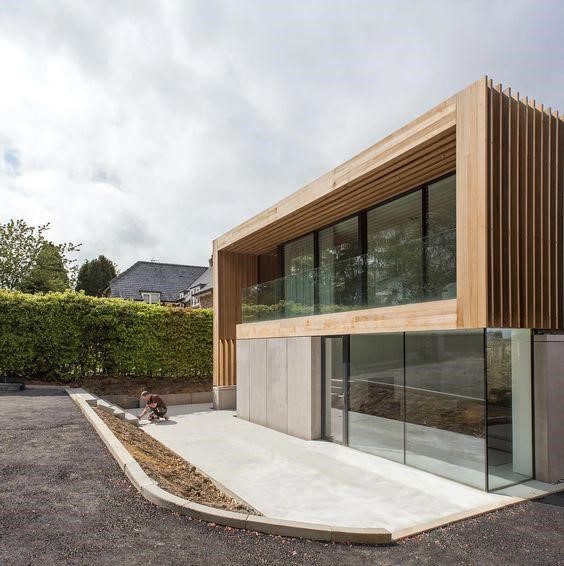
Source: Pinterest
10. Luxurious touch to low-budget house design
An open-air swimming pool can add opulence to a basic, low-cost housing design. It’s a feature that distinguishes your home from others with similar floor designs. Add a lot of greenery on the outside of the house. Use the glass railings for a more luxurious touch.
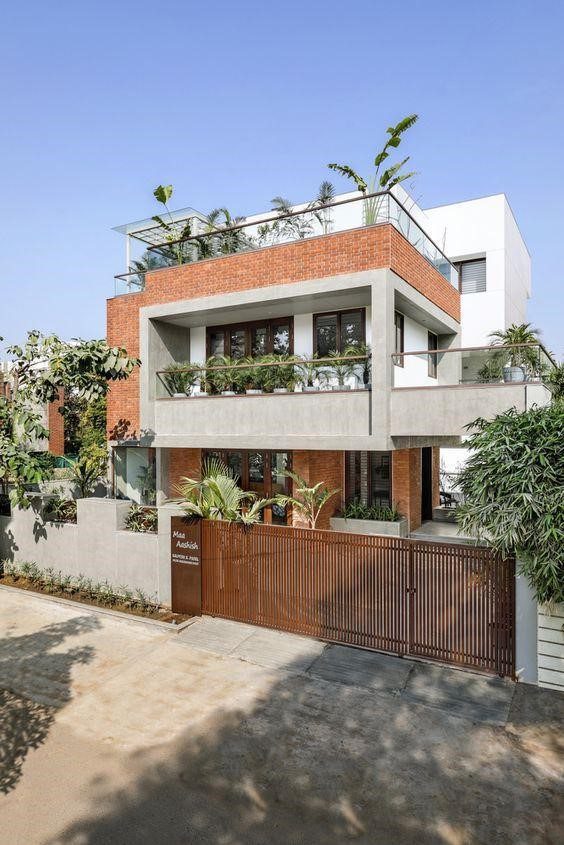
Source: Pinterest
11. Low-cost small house design with an attic
An attic is the area located between the roof and the ceiling of a home. Some homeowners cleverly transform this often-unused space into a storage area or even an extra bedroom. By adding a window and reinforcing the ceiling, you can create a cosy spot for a guest bed or use it as a discreet storage space. While attics are more common in Western homes, designers are increasingly incorporating them into Indian house plans. This approach allows you to gain extra space in a cost-effective manner.
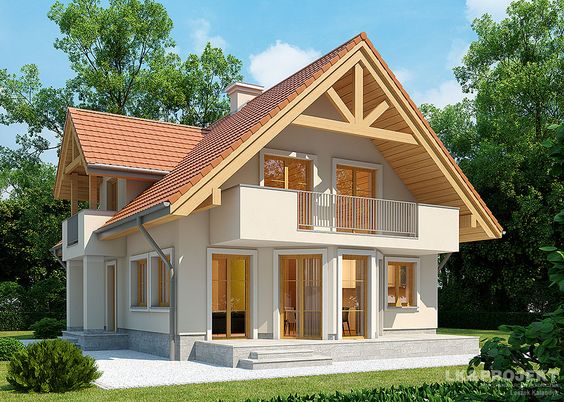
Source: LK&Project (Pinterest)
12. Box and strip low-cost small house design
If you’re short on time or money for a traditional house build, consider the box and strip method for your budget-friendly house design. This construction style uses standard-sized wooden blocks instead of traditional frames, cement, and other materials. The wooden blocks are assembled by nailing them together to form the structure, with a roof added on top. One of the key benefits of this method is that these houses can be dismantled and reassembled elsewhere in just a few days, offering great flexibility.
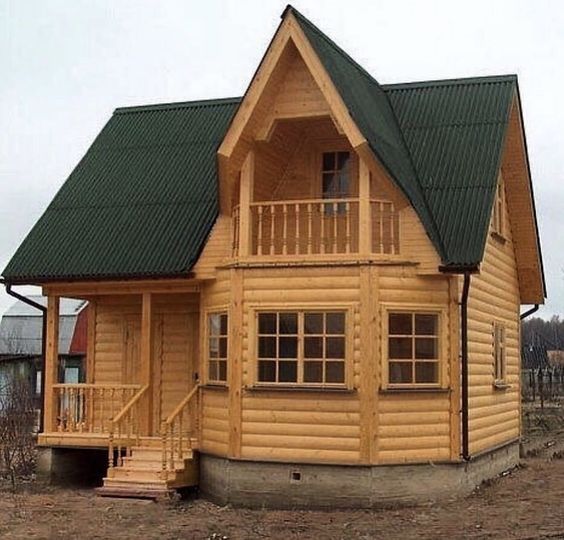
Source: Pinterest
13. A-frame low-cost small house design
The A-Frame house design is a cost-effective and straightforward architectural style typically featuring two bedrooms. This classic design has stood the test of time, recognized for its sharply sloped sides that extend from the foundation to a peak resembling the letter “A.” Its popularity is particularly evident in snowy climates, where the steep roof design effectively prevents heavy snow accumulation. Inside, the high ceilings foster a sense of spaciousness and accommodate a loft area that overlooks the living space below. While the A-Frame may appear simple, it can easily incorporate modern amenities, ensuring it offers the same comforts as a traditional home.
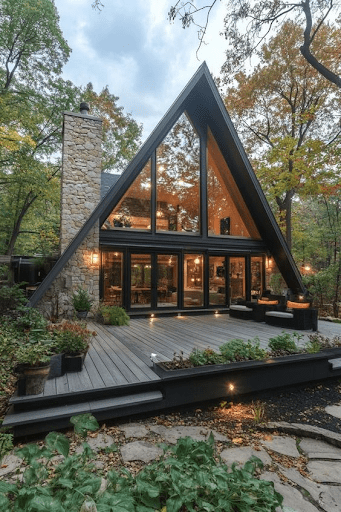
Source: Build Green (Pinterest)
14. Low-cost duplex simple house design
A duplex is a residential structure that consists of two separate homes, either placed side-by-side or one above the other. Each unit has its own private entrance, and they are often designed as mirror images of each other. Duplexes are favoured by homeowners who want to make the most of their land or generate rental income from the second unit. Though it contains two homes, each unit in a duplex offers all the amenities of a single-family house, such as a living room, bedrooms, kitchen, and bathrooms.
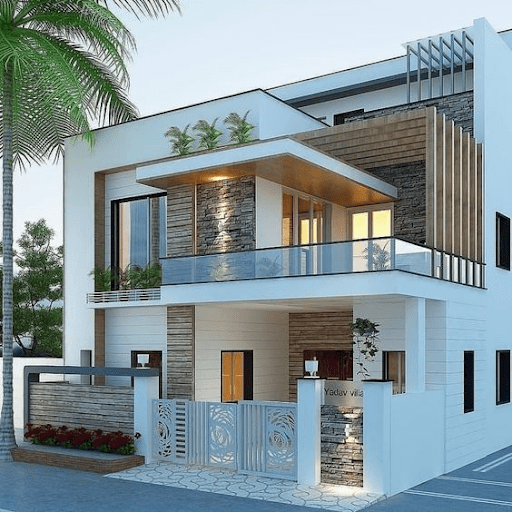
Source: Civil Engineering Discoveries (Pinterest)
15. Low-cost small house design with a flat roof
Flat roof houses are a contemporary and sleek option with several unique benefits. The flat roof can serve as additional outdoor space, ideal for rooftop gardens or outdoor lounges. This design typically falls under single-floor house designs and is especially popular in arid regions where heavy rainfall is not a concern. Flat roofs allow for high ceilings and large windows, creating an airy atmosphere filled with natural light. The interior layout is highly flexible, with room for open-concept living spaces. Despite the simplicity, flat roof houses can be equipped with modern amenities, making them a top choice for budget-friendly, stylish homes in India.
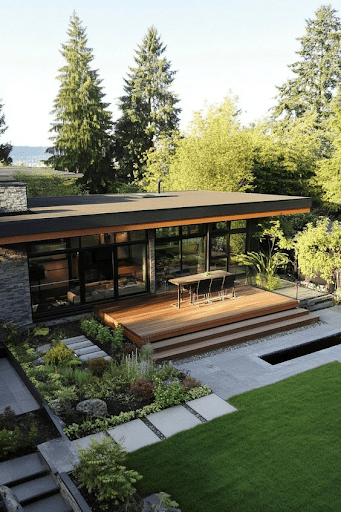
Source: Build Green (Pinterest)
16. Simple house design with skylights
Skylights are a brilliant addition to small house designs, bringing in natural light to brighten interiors and reduce energy costs. They create an illusion of larger spaces, making compact homes feel more open and airy. Skylights also improve ventilation, offering a sustainable solution for low-cost homes. Positioned in living areas, kitchens, or even bathrooms, these features enhance aesthetics while connecting you to the outdoors. Skylight designs are budget-friendly, practical, and perfect for a modern yet simple home.
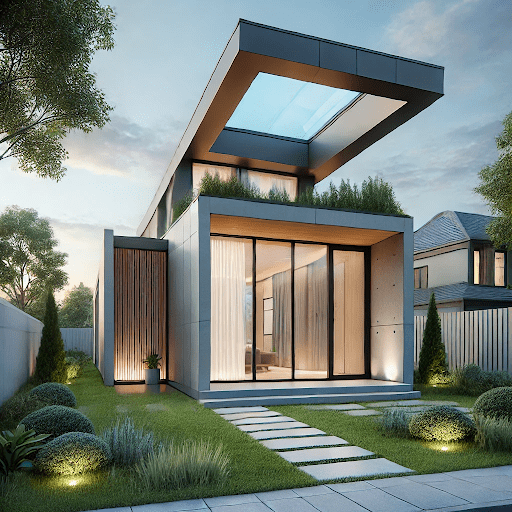
Source: Pinterest
17. Low-cost small house design with vertical gardens
Vertical gardens are an excellent choice for low-cost homes with limited space. These lush green walls enhance aesthetic appeal, improve air quality, and create a serene ambiance. They can be installed on balconies, exterior walls, or even indoor spaces. Low-maintenance and eco-friendly, vertical gardens are perfect for cultivating herbs, flowers, or small plants. This sustainable design element adds vibrancy to your home while staying affordable, making it a practical solution for compact living.

Source: Decor Facil (Pinterest)
18. Low-budget house design with a store
Incorporating a store into a low-budget house design is a smart way to merge business and living spaces. The store can be seamlessly integrated into the ground floor or a separate section, optimizing available space. Thoughtful planning ensures privacy and functionality, with distinct entrances or partitions. This setup is ideal for entrepreneurs, offering convenience and saving rental costs. It’s a practical, affordable solution for those seeking a functional home with added income potential.
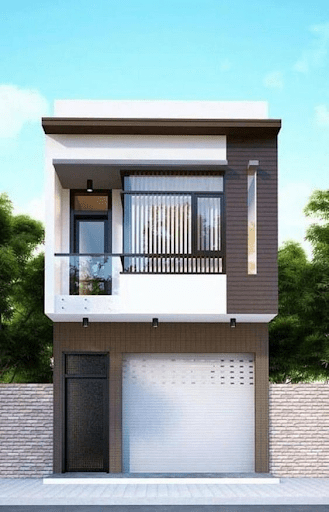
Source: Pinterest
19. Low-cost small house design with parking
Designing a low-cost home with parking ensures practicality and convenience for homeowners with vehicles. This can include a compact garage or a covered carport to protect your vehicle from the elements. Efficient use of space allows parking to blend seamlessly with the house layout, without compromising aesthetics or functionality. With careful planning, it’s possible to incorporate this feature within a budget, catering to modern needs while maintaining a clean and organized exterior.
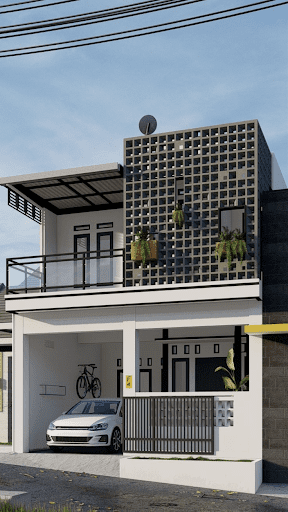
Source: Pinterest
20. Vintage-style low-cost simple house design
Vintage-style homes combine timeless charm with affordability, offering an aesthetic appeal that never goes out of style. Features like sloping roofs, wooden accents, and rustic finishes create a cozy and nostalgic atmosphere. Use reclaimed materials and classic designs like arched windows or antique doors to keep costs low. This style emphasizes simplicity and elegance, making it a perfect choice for budget-conscious homeowners looking for a home that exudes warmth and character.
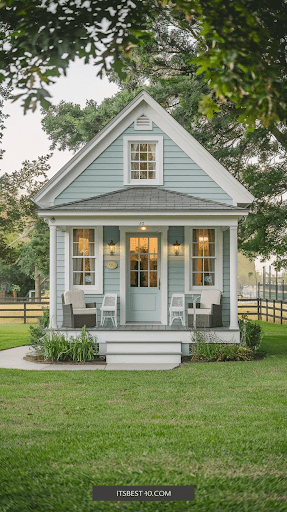
Source: Pinterest
21. Low-budget simple house design with a rooftop garden
A rooftop garden is a cost-effective way to enhance your home’s aesthetics and functionality. It provides additional green space, improves insulation, and helps regulate indoor temperatures, reducing energy costs. This eco-friendly design also creates a relaxing retreat for homeowners while maximizing limited land space, making it an excellent option for budget-conscious individuals who want a touch of nature in their living space.
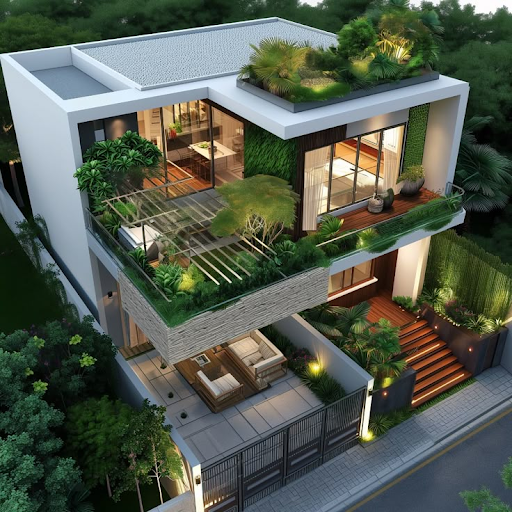
Source: Pinterest
22. Low-budget simple house design with full-length windows
Full-length windows bring in ample natural light, creating an airy and spacious feel without increasing construction costs. They enhance ventilation, reduce reliance on artificial lighting, and provide stunning outdoor views. This design is perfect for budget-friendly homes looking to achieve a modern, elegant aesthetic while maintaining energy efficiency. Proper window placement ensures privacy and comfort, making it a practical yet stylish choice for any home.
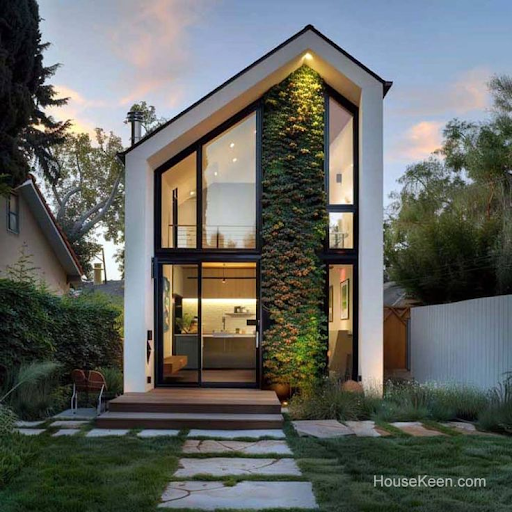
Source: Pinterest
23. Low-cost small house design with a central courtyard
A central courtyard in a low-cost home design brings in natural light and ventilation, reducing the need for artificial cooling and lighting. It acts as a private open-air space ideal for relaxation, gardening, or even small gatherings. Courtyard-centric layouts are both traditional and climate-responsive, making them suitable for Indian conditions while also adding charm without inflating the construction budget.

24. Low-budget house design with a sloped roof
A sloped roof design is a practical and economical choice, especially in areas prone to heavy rain. It facilitates efficient water drainage and protects the structure from leaks and water damage. Aesthetically pleasing and architecturally simple, sloped roofs can be built using cost-effective materials like metal sheets or tiles, keeping maintenance low while giving the home a distinct and timeless appearance.

25. Minimalist low-budget house design
Minimalist house designs focus on simplicity, clean lines, and clutter-free spaces. By eliminating unnecessary elements and emphasizing functionality, you can save on materials, labour, and maintenance costs. Open layouts, neutral colour schemes, and multi-functional furniture enhance space utility while keeping the design elegant and affordable. Minimalism suits those looking for a calm, practical, and budget-conscious lifestyle without compromising on aesthetics.

26. Low-cost small house design with a mezzanine floor
A mezzanine floor is an excellent space-saving solution for compact homes. By adding a partial upper level within a double-height space, you can create a cozy bedroom, study area, or storage loft without expanding the house’s footprint. This design maximises vertical space and adds functional versatility, ideal for small families or single occupants looking to stretch their square footage affordably.
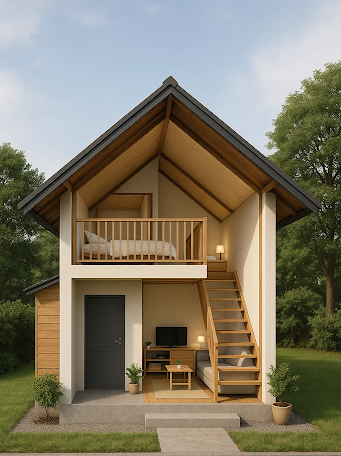
27. Low-budget house design with indoor-outdoor flow
Designs that encourage indoor-outdoor integration can make small homes feel larger and airier. Using sliding doors, large windows, or foldable walls that open onto patios or gardens extends the usable living area. This approach promotes natural ventilation, increases natural light, and enhances the aesthetic appeal, all while keeping structural changes minimal and cost-effective.
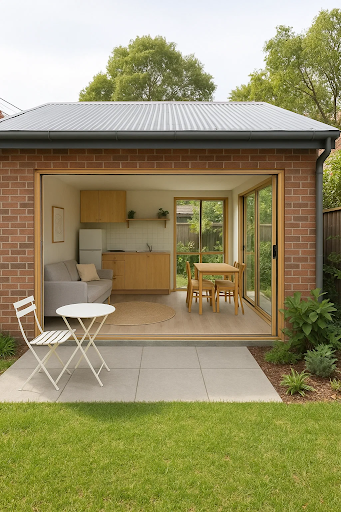
28. Low-cost small house design using recycled materials
Incorporating recycled or reclaimed materials like old wood, bricks, or corrugated metal can drastically cut construction costs while adding character. These homes not only reduce environmental impact but also offer a rustic, industrial, or boho aesthetic. This design idea is ideal for eco-conscious homeowners looking to build unique, budget-friendly spaces with a lower carbon footprint.
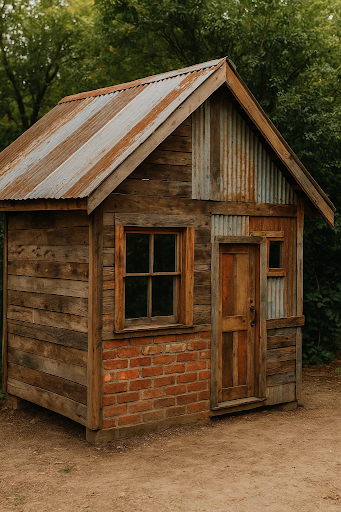
29. Low-budget house design with pergola-covered entrance
Adding a pergola to the entrance or porch area can instantly elevate the look of a low-budget house without high construction costs. Built using wood, bamboo, or metal, a pergola provides a shaded semi-open structure that can be enhanced with climbing plants, hanging lights, or even a simple bench. It serves both aesthetic and functional purposes, offering curb appeal while defining the entryway. This feature pairs well with minimalist façades and creates a welcoming transitional space from the outdoors to indoors.
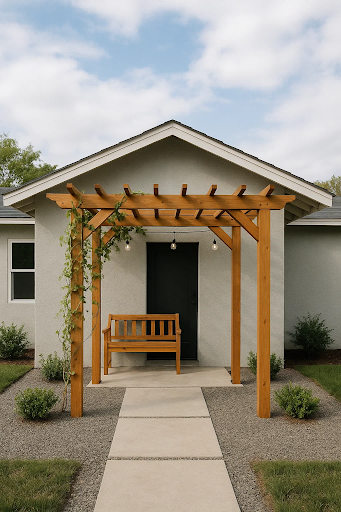
30. Low-cost house design with external wall cladding
Using budget-friendly external cladding materials like fibre cement boards, reclaimed wood panels, or stone-textured tiles can dramatically improve the appearance of a small house. These claddings not only add visual depth and contrast but also provide insulation and protect the structure from weathering. Opting for partial cladding, on just one façade or around windows, helps keep costs low while achieving a premium, modern finish. It’s a smart way to add texture and colour variation to a plain exterior on a budget.

Low-budget simple house design: Elevation ideas
The elevation of a house defines its external appearance, making it the first impression for visitors. A well-planned elevation not only enhances visual appeal but also adds character to the home. If you are looking for cost-effective yet stylish single-floor house elevation ideas, here are some inspirations:
- Contemporary style: A modern look can be achieved by blending different textures like cement, wood, and stone. Elegant yet minimalistic designs, paired with strategic outdoor lighting, create a sophisticated appearance.
- Traditional design: For a classic touch, carved wooden panels, sloping roofs, and clay tiles can bring warmth and heritage to the house. Soft, earthy-toned paints further enhance the traditional charm.
- European influence: Inspired by European architecture, this style incorporates stone or brick facades, large windows, and arched doorways, lending a grand and timeless appeal to the home.
- Fusion approach: A unique elevation can be designed by mixing different styles—such as a blend of contemporary minimalism with traditional roof designs—creating a budget-friendly yet distinctive exterior.
How to design a small house on a budget?
Designing a house on a low budget requires careful planning and creative solutions. Here are some steps to consider when designing a house with limited financial resources:
- Set a realistic budget: Determine the maximum amount you can afford to spend on your house design and construction. This will help you make informed decisions throughout the process and prioritise your expenses.
- Optimise the use of space: Focus on maximising the functionality of every square foot in your house. Design an open floor plan that allows for multi-purpose spaces, such as combining the living room, dining area and kitchen. This approach minimises the need for additional rooms and saves construction costs.
- Keep it simple: Choose a minimalist design concept that reduces the need for excessive decoration and complex architectural elements. Simple lines, clean finishes and a straightforward layout can create an elegant and cost-effective design.
- Utilise natural light: Incorporate ample windows and skylights in your design to maximise natural light. This reduces the need for artificial lighting during the day, saving on energy costs. Additionally, natural light enhances the sense of space and creates a bright and welcoming atmosphere.
- Use affordable materials: Explore cost-effective building materials without compromising quality. For example, consider using locally sourced materials or recycled materials that are budget-friendly. You can also opt for durable, low-maintenance materials that save on long-term expenses.
- Prioritise energy efficiency: Design your house with energy efficiency in mind. Incorporate insulation, proper ventilation and energy-efficient appliances to reduce utility costs over time. This includes selecting energy-saving lighting fixtures and installing solar panels if they fit within your budget.
- DIY where possible: Take on do-it-yourself (DIY) projects for non-structural elements, such as painting, landscaping or simple interior renovations. This can significantly reduce labour costs and allow you to personalise your space according to your preferences.
- Consider modular or prefabricated construction: Explore the option of modular or prefabricated construction methods. These approaches are often more cost-effective and time-efficient compared to traditional construction methods. They involve the use of pre-made components that can be assembled on-site, reducing labour and material costs.
Small house design: Challenges
Decorating a small space poses several challenges that require creative solutions:
- Limited design ideas: The restricted space may limit the incorporation of numerous design ideas.
- Cluttered appearance: Even a few furnishings or decorations can give a small house a cluttered look.
- Insufficient windows: The lack of enough windows can be addressed by strategically placing large mirrors to enhance natural light.
- Dead spaces: Figuring out how to utilise dead spaces, such as small reading corners or galleries, can be confusing.
- Maximising functionality: Achieving more functionality with less space can be a challenging aspect of small space design.
- Small kitchen challenges: Small kitchens may appear cramped and cluttered, making organisation a challenge.
- Limited floor space: Finding ways to free up floor space becomes a significant concern in small spaces.
Tips to maximise space while designing a low-budget small house
Designing a small house on a limited budget requires smart strategies to make the most of the available space. Here are some tips to help you maximise space while designing your low-budget small house:
- Opt for open floor plans: Embrace open floor plans that eliminate unnecessary walls and barriers, creating a sense of spaciousness. This layout allows natural light to flow freely, enhances the visual appeal and provides flexibility in furniture placement.
- Utilise vertical space: Make use of vertical space to maximise storage and functionality. Install floor-to-ceiling shelving units, wall-mounted cabinets and overhead storage to store items and keep the floor area clutter-free. Consider utilising wall space for hanging plants, decorative elements or even a folding desk.
- Multi-purpose furniture: Invest in multi-purpose furniture that serves dual functions to save space. Look for sofa beds, folding tables, storage ottomans and wall-mounted desks. These versatile pieces allow you to make the most of limited space by providing functionality when needed and easy storage when not in use.
- Built-in storage: Incorporate built-in storage solutions to minimise the need for additional furniture. Custom-built shelves, cabinets, and closets can be tailored to fit the available space and provide ample storage for your belongings. Utilise under-bed storage, hidden compartments and recessed niches to maximise storage options.
- Use light colours: Opt for light colours on walls, ceilings and furniture to create an illusion of a larger space. Lighter shades reflect natural light, making the room appear more open and airy. Consider using a cohesive colour palette throughout the house to maintain a cohesive and spacious feel.
- Mirror magic: Strategically place mirrors to create an illusion of larger space. Mirrors reflect light and create a sense of depth, making the room feel more expansive. Consider placing mirrors opposite windows or near light sources to maximise the effect.
- Sliding doors: Replace traditional hinged doors with sliding doors to save space. Sliding doors take up minimal floor space and provide easy access to different areas without obstructing walkways. They are particularly useful in compact spaces like bathrooms, closets, and small rooms.
- Outdoor living: Extend your living space to the outdoors by creating a functional outdoor area. Utilise balconies, patios or rooftops as an extension of your living space. Add seating, potted plants and lighting to create an inviting outdoor retreat.
Common mistakes to avoid in low-budget house design
When designing a low-cost small house, avoiding common mistakes can ensure the project stays within budget while delivering a functional and aesthetic home. Here are some pitfalls to steer clear of:
- Overlooking a detailed plan: Skipping a thorough plan or blueprint can lead to unexpected expenses. A well-thought-out design, accounting for materials, labor, and contingencies, is essential for cost control.
- Compromising on quality: Choosing the cheapest materials may save money initially but can result in higher maintenance and repair costs in the long run. Strike a balance between affordability and durability.
- Ignoring space optimization: Poor use of space, like excessive hallways or underutilized areas, can make a small house feel cramped. Focus on multipurpose furniture and designs that maximize every square foot.
- Underestimating local climate conditions: Failing to consider climate-appropriate designs can lead to discomfort and higher utility costs. For example, a poorly ventilated home in a hot region may increase cooling expenses.
- Overloading with unnecessary features: Including too many design elements, like decorative structures or complex layouts, can drive up costs without adding value. Stick to essential features that enhance functionality and aesthetics.
- Skipping professional help: While DIY solutions may seem economical, neglecting professional advice from architects or contractors can lead to costly mistakes. Seek guidance for technical aspects to ensure long-term savings.
Important Vastu tips for small home designs
Even compact homes can benefit greatly from Vastu-compliant planning. Here are key Vastu tips to help you design a small home that attracts positivity, comfort, and balance:
- The main entrance should face north, east or northeast, as these directions are considered auspicious and allow good energy flow into the house.
- Place the kitchen in the southeast corner of the home (Agni Kon); if not possible, the northwest is an acceptable alternative.
- The master bedroom is best located in the southwest, providing stability and restful sleep.
- The living room should ideally be in the north or northeast, which fosters family bonding and mental clarity.
- Bathrooms should be placed in the west or northwest, and should not share walls with the kitchen or pooja area.
- A prayer or pooja area should face east or be located in the northeast corner for spiritual harmony, even if it’s just a wall-mounted niche.
- Use mirrors on north or east-facing walls, but avoid placing them directly opposite the bed.
- Choose light, earthy colours like cream, beige, pale yellow, or light green to enhance natural light and create a soothing ambience.
- Maximise natural ventilation and sunlight through windows on the north and east sides of the house.
- Keep the central zone (Brahmasthan) open and clutter-free, avoiding heavy furniture in the middle of the house.
Housing.com POV
Low-cost small house designs offer an excellent way to achieve financial savings and environmental benefits. These designs prioritise efficient space utilisation, making even compact homes feel larger and more functional. From open floor plans to multi-section layouts, and from exposed brick aesthetics to open patios, these creative solutions cater to various needs and preferences. By adopting such innovative design ideas, you can create a beautiful, cost-effective, and sustainable living space that perfectly suits a simpler, more efficient lifestyle.
FAQs
What are the general features of a low-budget house design?
A front patio or balcony, a living space, a kitchen, a dining room (optional), one or more bedrooms, and bathrooms are all essential characteristics of such a low-cost single-floor house design. Depending on the size of the plot, there might be extra features.
What will be the cost of building a low-budget house design?
A low-cost house can be built within any financial range. You can choose from a few house plans with a budget of Rs 7 lakh to Rs 10 lakh.
Can I design my own house?
Designing your own house is an achievable goal, and you can create house plans using floor plan software, even if you're not a professional. Drawing your own plans allows for customization and a personal touch to your home.
What is the cheapest shape to build?
The cheapest shape to build a home is often a simple floor plan. Opting for a square or rectangular layout makes the construction and design process more straightforward. Building upward, such as having multiple floors, is generally more cost-effective than constructing a sprawling one-story home.
What is a floor plan?
A floor plan is a scale drawing that illustrates the relationships between rooms, spaces, and physical features when viewed from above. These plans serve as a visual representation, allowing you to understand how people will navigate and move through the space.
| Got any questions or point of view on our article? We would love to hear from you. Write to our Editor-in-Chief Jhumur Ghosh at jhumur.ghosh1@housing.com |







